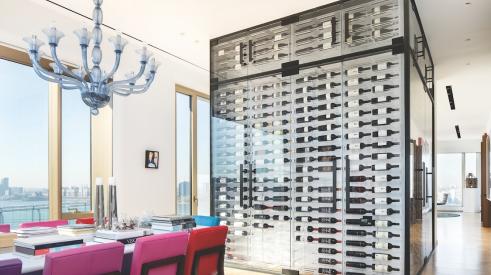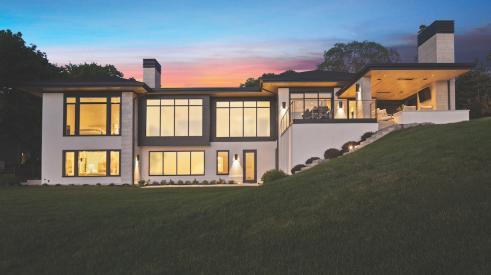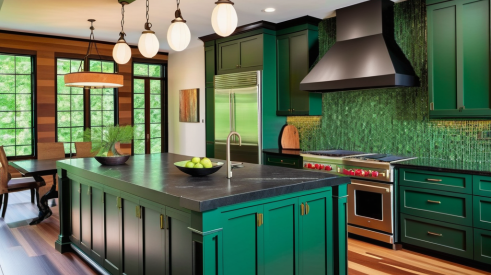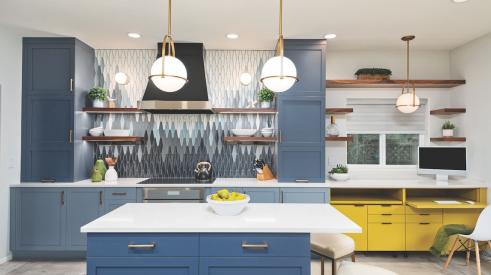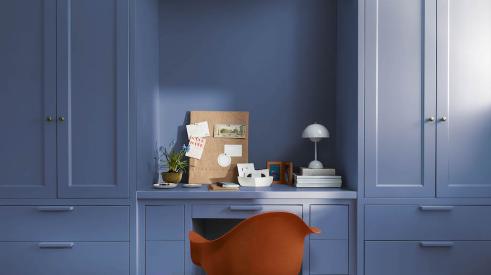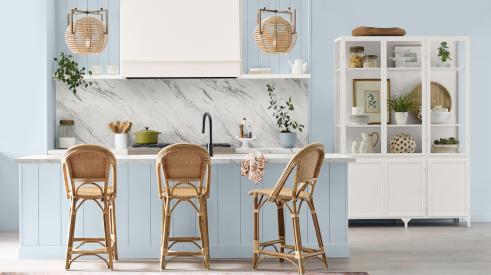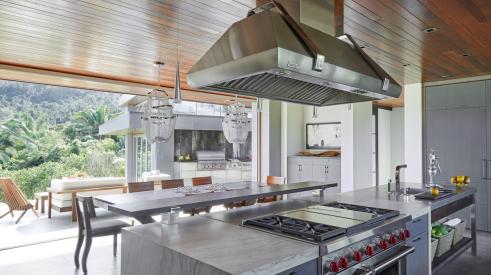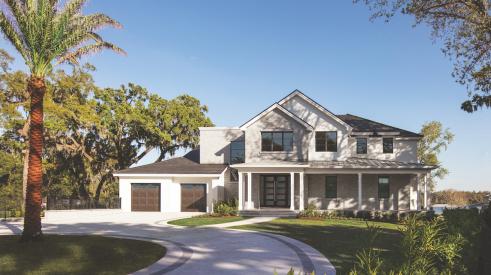 |
| This living room includes natural grass window coverings; a reclaimed teak floor; a glass mantle; fiberglass windows; and a reclaimed teak balcony railing with glass balusters. Cork floors were used elsewhere in the home. Photo courtesy of Spectrum Fine Homes |
Healthy living and soaring energy costs have their place in dinner table conversations around the country. The same holds true for the remodeling community; remodelers are finding their clients more enthusiastic than ever when it comes to embracing sustainable, or green, building concepts.
Teaming up with the burgeoning number of local, state, and national green building programs, remodelers have an opportunity to spread the word that the rewards of green remodeling can be significant without taking a bite out of the bottom line and while differentiating themselves from competition. And manufacturers are responding by flooding the market with new products and materials to meet escalating consumer demand.
"Remodelers who are knowledgeable about green concepts have a tremendous opportunity to differentiate themselves in their marketplace and increase their profit margin," says certified green remodeler Michael Strong of Houston-based Brothers Strong and GreenHaus Builders. "As for the client, they get a much healthier living environment and save money by reducing their energy usage."
Experts like Strong agree that everyone benefits by adopting green building techniques and materials — including those that improve a home's energy efficiency and indoor air quality — specifying products that come from renewable resources, and salvaging or recycling demolition and construction debris whenever possible.
"It seems that everything in the news these days supports the concept of green building," says Susan Davis, a certified green building specialist with Spectrum Fine Homes, a Mountain View, Calif.-based renovation firm that incorporates green concepts into about 98 percent of its projects. "Not only are we improving the lives of our clients, but we're also promoting healthier working conditions for our employees by minimizing their contact with potentially harmful substances. And, by using local resources, materials and people, you not only support your local economy, but you also reduce transportation and energy costs on a global scale."
"One of the greatest things about green remodeling is that it is not an all-or-nothing-thing," says Jerome Quinn, president of Atlanta-based SawHorse and one of the creators of the city's EarthCraft House Renovation Program that focuses on making existing homes more energy-efficient and healthy. "It's about starting on a process that can be as ambitious as the client wants it to be. I compare it to going on a diet. You can go all out, but even losing five pounds will make a difference."
 |
| The kitchen's maple cabinets are certified by the Forest Stewardship Council as sustainably harvested and containing no formaldehyde. Other green products and materials incorporated into the kitchen's design include fiberglass, dual-pane windows; low-VOC paint; reclaimed teak flooring; recycled tile; fluorescent and LED lighting; lava stone countertops; and glass shelving. Photo courtesy of Spectrum Fine Homes |
Does green remodeling increase costs? "That depends on which shade of green the project is," says Strong. "There are fundamental green practices and materials that you can adopt that will not affect the budget." Going beyond the basics, he says, might add 20 percent to the tab, but the money comes back in savings.
"The starting point," says Quinn, "is to do a better job sealing the building envelope with additional caulking, improved insulation and radiant barrier roof decking. This can be a function of using new techniques and materials rather than spending more money."
Don't discount the learning curve associated with converting from conventional remodeling practices to green ones, warns Davis. "Researching and procuring new materials and educating your employees can take more time, particularly when you're trying something new. Your estimator has to account for this when setting up the budget for the project."
 |
| An improperly insulated attic or damp basement can lead to problems with indoor air pollution, including mold and mildew, says Atlanta remodeler Jerome Quinn. Photo courtesty of SawHorse Inc. |
"People buy comfort, luxury, and status," says Strong. He recommends selling the healthy living component of green remodeling first followed by lower maintenance costs, better performance and energy efficiency.
"We demonstrate that the way to achieve this is by product selection, such as choosing Energy Star appliances, using low- or no-VOC materials, and altering construction methods and design considerations," Strong says. "We include a 'green page' with our proposals to get the client thinking in these terms."
One way to steer clients toward green products is to prove their return on investment.
"We find that most people will choose a green alternative if the cost is right," says Davis.
 |
| A green home does not have to be ultra-modern, says Susan Davis, CKBR, ASID. "Every architechtural style can support the green concept." This traditional kitchen includes high-performance Andersen windows, recycled tile for the backsplach and energy-efficient appliances. Photo courtesy of Sawhorse Inc. |
Green remodelers recommend starting with a performance audit by an outside contractor to determine operating efficiency of their client's home as well as to identify areas of concern for indoor air quality such as windows, doors, insulation and HVAC equipment. Once a project is completed, the home can be reanalyzed to quantify the homeowner's savings.
Salvaging and recycling materials is also key, says Davis. She uses a deconstruction sub-contractor that specializes in sorting, salvaging and recycling materials from the job site to earn a tax credit for her homeowners.
Davis contributes articles on green remodeling to industry trade journals and gives presentations to local community and environmental groups and at home shows, local furniture stores and building supply centers. "This costs time rather than money and demonstrates our company's commitment to the concept, giving us huge credibility with our clients," she says.
"The challenge is not a lack of information about green remodeling but collating it into something practical for your own use," says Strong. He recommends a bite-at-a-time approach. Make changes first in areas where you're comfortable.
"Search out remodelers in your own neck of the woods who are already embracing green practices and get advice from them," recommends Quinn. "They'll let you know what has worked for them and what has not."
Recognize that the technology associated with green remodeling is constantly evolving, says Davis. The Internet remains one of the most helpful tools for remodelers and homeowners alike when looking for the most current information about sustainable building. "I learn something new on every project, and I find my clients better informed and more willing to be part of the process than ever before," Davis says. "There is a synergy that happens on a green remodeling project that sets it apart from a conventional one."
Remodelers are finding clients more enthusiastic than ever when it comes to embracing green concepts
Add new comment
Related Stories
This New Tech Turns Any Countertop into a Wireless Charger
FreePower for Countertop has swept awards for its innovation—and the company claims installing it is "as straightforward as cutting a sink"
Designing, Building, and Installing a Luxury Custom Wine Cube
An 11-foot wine cube enveloping a pantry is the stand out feature of this customized New York penthouse
Marvin Releases Switchable Privacy Glass Window
The privacy glass windows can be purchased from Marvin's Direct Glaze windows
Building A Small Projects Division from the Ground Up
Through hard work and careful strategy, Harth Home Services has seen big growth
Client Design Choices in the Time of Social Media and AI
Social media speeds up the trend cycles, and now artificially created images are falling into homeowners' hands
Design Trends to Watch in 2024
What’s in and out for the upcoming year? Remodeling designers share insights
Insights for Designing Outdoor Kitchens
Was the pandemic-fueled thirst for outdoor kitchen remodels and additions a fluke, or is it here to stay? Plus: The top design considerations for outdoor kitchens
Home Run Remodeling Lessons: The New American Remodel 2023
A final look at The New American Remodel 2023




